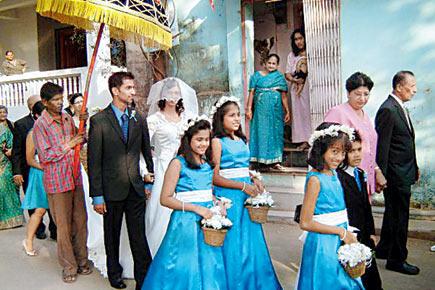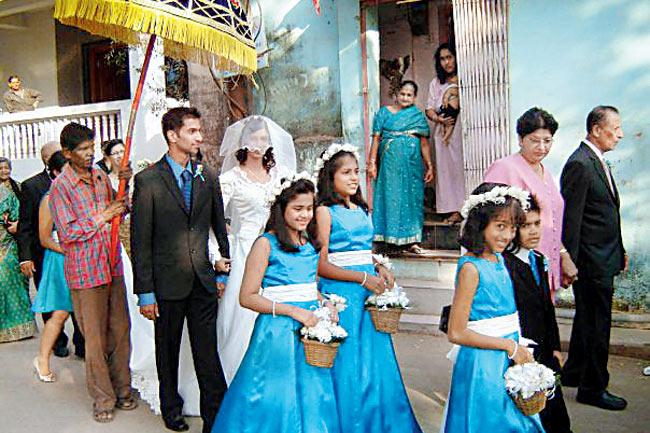You can take the girl out of Bandra, never Bandra out of the girl. This Queen of Suburbs bonds uncommonly. Bandra girls, even generations apart, exult on finding each other years later.

 You can take the girl out of Bandra, never Bandra out of the girl. This Queen of Suburbs bonds uncommonly. Bandra girls, even generations apart, exult on finding each other years later. On a walk through Ranwar village to track vintage East Indian homes left standing in the alleys of my childhood, I bump into Teresa Marquis outside the oratory chapel. She taught me music at St Joseph’s. It’s 40 seasons since, yet my mind leaps straight to a New Seekers’ song we warbled with her — ‘I’d like to teach the world to sing in perfect harmony…’
You can take the girl out of Bandra, never Bandra out of the girl. This Queen of Suburbs bonds uncommonly. Bandra girls, even generations apart, exult on finding each other years later. On a walk through Ranwar village to track vintage East Indian homes left standing in the alleys of my childhood, I bump into Teresa Marquis outside the oratory chapel. She taught me music at St Joseph’s. It’s 40 seasons since, yet my mind leaps straight to a New Seekers’ song we warbled with her — ‘I’d like to teach the world to sing in perfect harmony…’
Perfect harmony: words which echo the rhythmic lilt of life from the time of early East Indian settlers in Bandra, that scenic Salsette Island tip inhabited by Koli fishermen and farmers. Bandra being with the British East India Company (the rest of Bombay went to the Portuguese) the English converted its ethnic Marathi families to Christianity. Paddy cultivators became thriving proprietors of fields fully fertile, strategically situated. Commerce bustled between the mainland and British Bombay by ferry from Bandra port, guarded with a fort still perched at Land’s End.
ADVERTISEMENT

An East Indian bride under the 'satir" umbrella. Pic/Jason Pinto
An influx of Christians from Goa, Kerala and Karnataka prompted local converts to take on the name East Indians. Forming the East Indian Association in May 1887 they distinguished themselves, as sons of the soil and employees of the East India Company, from Indian Christians further down the west coast. They shared the same religion, though, besides vying for jobs.
A post-War building boom began to accommodate migrants in the picturesque villages of Malla, Sherly, Rajan, Kantwady, Waroda, Boran, Pali and Chuim, Bandra’s last heritage precincts. Available in the 1940s at rents ridiculous as R25, stray cottages spring surprises — an attic storing grain and harvesting implements, the remnant of a Greek monograph of Christ, chintzy crockery on elegant sideboards.
I smile to hear my friend, writer Dilip D’Souza, describe the thick cultural stew: “Strolling in Chimbai village you’re among native fish sellers, as well as Muslim and Hindu settlements rubbing shoulders with Catholic shrines. It’s great listening to a Hail Mary and Hindu chants recited almost together.”
Nowhere in the city is Christmas more vibrantly greeted than in Bandra. This is the month to revisit the littlest lanes lined with twinkling trees under the red roofs of Ranwar and typical terraces of Pali. Till 1930, residents rode a solitary bus service plying across the village green from Pali Naka to the train station. Chuim had just one car, a rattling Vauxhall school kids nicknamed ‘Valkee’ but hastily declined rides in — “Thanks Uncle Alfie, we’ll walk faster.” They did. On paths that hid shy courting couples on the Sherly Rajan beach sands or around Danda Green’s 18-hole golf course.
Many a match made at Ranwar Club’s festive dances, traditional nuptials were weeklong whirls. Whole villages showed up, says Marie Concessio, a Pali old-timer who produces calendars on colourful aspects of East Indian life; her 2011 theme was community weddings. The merriment was marked by rousing revelry specific to certain days. Thursday was reserved for slaughtering the pig. On Friday papads were pounded as spicy snacks with drinks. Saturday saw sweet fugias fried and water drawn from the village well — “umbracha pani” — to bathe the bride and groom. Sunday dawned for the ceremony and reception celebrated with cheery band tunes. The young man went to Church under a glittering umbrella, the “Satir”, before sending it for his bride. Petals of sunny marigold flowers, favoured by both Maharashtrians and East Indians, got flung in fistfuls over the happy couple before confetti balls replaced that custom. Monday followed as rest day, to finish feasting on the previous night’s roast pork and black grape wine. On Tuesday guests’ feet were washed and a farewell dinner on Wednesday flagged down the fun till it was goodbye
on Thursday!
Lucky if you’re invited to an East Indian wedding. Till then there’s comfort at least in saying thank you for the music. Afternoon sounds of pianos tinkling, guitars strumming, choirs trilling. Mellow thoughts far from the reality of the rapacious builder’s axe, village upon sleepy village snoozes after lunch. For a few fleeting hours all’s right with their world.
Meher Marfatia loves Mumbai. And adores Bombay.
Reach her on: mehermarfatia@gmail.com
 Subscribe today by clicking the link and stay updated with the latest news!" Click here!
Subscribe today by clicking the link and stay updated with the latest news!" Click here!







